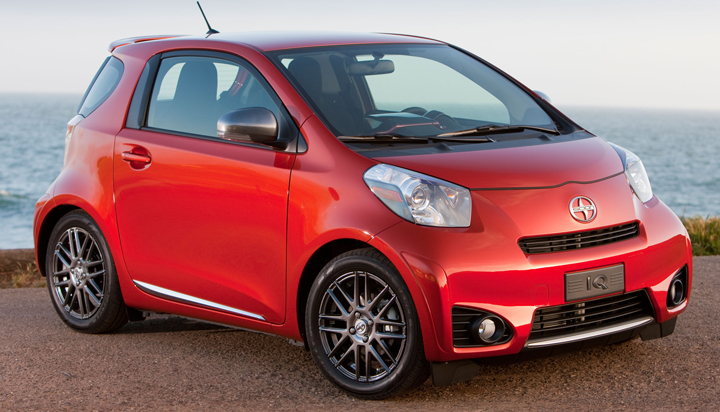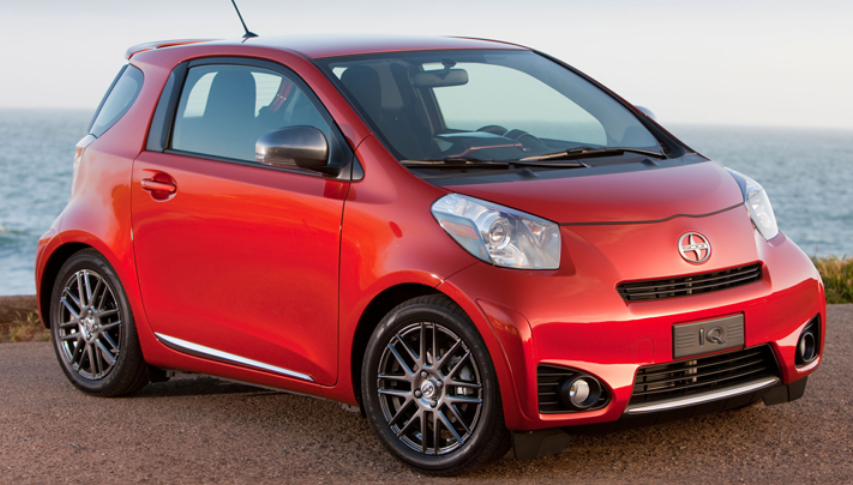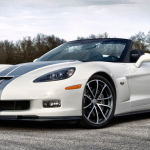
Test car came equipped with: TRD rear sway bar and performance springs; rear spoiler; Pioneer premium HD audio; satellite radio; foglights; illuminated door-sill kit and interior light; automatic-transmission shift knob; carpeted front and rear floormats. Total MSRP with $730 destination = $19,135.
Scion iQ
Rating the 2012 Subcompact Cars, #1-14
Powertrain: 90-horsepower 1.3-liter 4-cylinder engine, continuously variable automatic transmission (CVT), front-wheel drive

Acceleration: Car and Driver clocked 0-60 mph in 9.6 seconds, but my tester didn’t feel that quick. Low-10s, maybe. My colleagues say the “iQ takes off with authority,” but I can’t agree. It does get away from stoplights reasonably well, but only if you nail the accelerator. I do agree that this teeny Toyota—sorry . . . Scion—“is no speed demon” otherwise, but it copes well enough with routine city/suburban traffic here in Phoenix. The transmission’s Sport mode makes for a slightly livelier feel, but I may be imagining that. Though being in such a small car around big trucks on freeways made me a little anxious, the iQ cruises easily (though not quietly) at 70 mph—on the flat. I have no doubt that maintaining speed up even moderately steep hills will be a challenge. And even on a level road, the relative lack of power means you’ll have to plan well ahead for passing maneuvers. Then again, this is primarily a low-speed “city car.”
Why did Aston Martin build a car based on the Scion iQ?
I’ve never liked most CV transmissions because of their hesitant, slurred “shift” action, and I don’t like the iQ’s. An ordinary manual gearbox would not only improve performance but would make the car more fun to drive. The only reason I can think of for Toyota using a CVT here is that it might be a little more compact than a manny-tranny, and the iQ is all about space-efficiency.
Fuel Economy: I averaged 44.2 mpg in a roughly 50/50 city/freeway driving mix—and don’t ask me how, as the EPA estimates are 36 mpg city, 37 highway, and 37 combined. It’s rare when I better gummint ratings, let alone to this degree. However, the label also cites “2.7 gallons per 100 miles,” and I used 2.487 gallons for about 110 miles, so my result isn’t totally out of line.
Ride Quality: I haven’t sampled a base-suspension iQ, but this tester had a pretty miserable ride with its optional TRD springs and rear sway bar—no surprise, as TRD stands for Toyota Racing Development. In any case, such “upgrades” work against comfort in a light car with such a short wheelbase and apparently limited suspension travel that is bound to be hoppy-choppy already. Stiff run-flat tires (all-season 175/60R16-82H Goodyear Assurance in this case) don’t help, but they’re mandatory to eliminate the need for a space-consuming spare. My colleagues give the sport-suspension iQ a “3” in this category, but I think a “2” would be closer to the truth. As equipped, my test car seemed to magnify even small pavement blemishes, and it rocked enough over my driveway’s sharp easement to knock my noggin on the outboard roof rail. So much for “head toss” occurring only off-road in certain SUVs.
Check out Consumer Guide’s Subcompact Car Best Buys
Steering/handling/braking: A car this small should be maneuverable and easy to park. The iQ is that and more, but it requires more than usual concentration in normal driving. The steering is not only numb on-center, as the main report says, it’s super-light and super-quick. It’s so sensitive that a sneeze could punt you into another lane. Being such a banty, the iQ also wanders when big trucks blow by and in even moderately brisk breezes. I would not want to drive this car in a gusty thunderstorm. I agree that cornering lean is noticed but not alarming, though it’s not a major concern anyway, as there’s not a lot of power for gunning through turns. My colleagues say the brakes are “reassuring, delivering drama-free stops on most surfaces.” That seems right to me, although I think that suspension hop might be a problem on very bumpy pavement. In fairness, the iQ isn’t meant to be a speedy open-road corner-carver, and it doesn’t feel at all top-heavy despite appearance. Also, full credit to Toyota for the reassurance of standard ABS, traction control, and stability system.
Quietness: The only thing I’d add to the main-report comments is that I found the iQ surprisingly tolerable at 65-75 mph. It’s not the punishing buzz-box one might expect, though you will need to turn up the stereo quite a bit.
Controls: I, too, like the simple three-knob climate controls, but the buttons in the middle of each dial—for A/C on, recirculation, heated rear window—are small and too low down for easy on-the-move use, especially given this car’s jiggly ride. The tester’s optional Pioneer stereo is another of those designs that I find confusing and frustrating. It relies on just one knob to handle multiple functions selected from touch-points on the faceplate or display screen. Trouble is, the touch-points are too close together, most have cryptic icons, and the whole business washes out in even moderately strong daylight. The system sounds good, but the controls are rubbish.
Details: Interior materials may be “appropriate for the class,” as the main report says, but I think the iQ cabin is too low-rent in light of my car’s $19,000 as-tested price. There’s really nothing special about it with the possible exception of the “metalflake” black-plastic accents, and those just seem tawdry. In addition, doors close with a tinny clang, which also doesn’t exactly convey a sense of “quality.”
Room/comfort (front): The main report says what needs saying in this department, except for one thing. The seats are high enough off the floor to put 6-footers’ heads above the top of the door windows, which means that taller occupants need to crouch a bit on entry/exit to avoid unwanted cranial collisions. This flaw only highlights the need for seat-height adjustment. The seats themselves are econocar-ordinary: OK for short hops, but probably not for long-distance comfort.
Room/comfort (rear): My colleagues mostly have it right here. The truth is that the iQ’s short cabin length makes a very tight fit for two 6-footers sitting in tandem on the right. And no sane grownup should attempt to ride there anyway, as headroom is minimal and the seat is flat and hard. The space is really for smaller children, practically speaking, but I fear for the safety of any rear passenger, given how little “crush space” there is behind.
Cargo Room: The main report mentions an underseat drawer on the right, but it’s gotta be an option, as the test car didn’t have it—and more’s the pity, given how little storage there is otherwise. Customers in other markets get a handy two-section map pocket on the lower right of the dash, but that’s a no-go for the U.S. due to the standard front knee airbag.
CP Says . . . The main report summary is fair and diplomatically worded, but I don’t think the iQ is a very good car, however much sense it may make in dense urban jungles such as Paris, Tokyo, and Manhattan. I admire its clever space-saving design, and it’s a more professional and polished city runabout than the quirky Smart ForTwo. But it’s also pricey for what it is and does, and just a few options can run up a tab that buys a “real car.” For example, the tester’s silly illuminated doorsill plates alone cost nearly $600, and I cannot understand the $55 “shift knob AT.” Does that mean the stick otherwise comes with no knob at all?
To repeat, the iQ was conceived mainly as an exercise in space-efficiency, and in that regard it’s brilliant. But the very concept entails so many practical compromises that I cannot recommend this car, even as a dedicated commuter ride for multi-vehicle households. It might be OK if the base price were $12,000 instead of $15,265, but as it stands the iQ is neither a good value nor a brainy small-car choice.
Electra “cute” : The 2014 Smart ForTwo Electric Drive
Scion iQ



